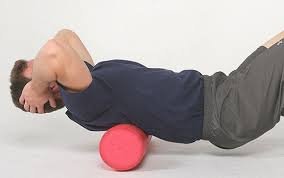Self-Myofascial Release (SMR) is a self-massage technique designed to target the myofascial system — the muscles and the connective tissue (fascia) surrounding them. The goal is to relieve tightness, reduce muscle soreness, and improve flexibility by applying pressure to specific areas known as trigger points or “knots.”
The fascia is a web-like layer that covers and connects every muscle and organ in the body. When it becomes restricted due to overuse, poor posture, or inactivity, it can lead to pain and stiffness. SMR helps release these restrictions, restore mobility, and improve how muscles glide and function.
The “self” part of SMR means you can do it on your own, without a therapist, using simple tools such as foam rollers, massage balls, or sticks to work on areas that feel tight or sore.
How Foam Rollers and Massage Balls Help
Foam rollers and massage balls are two of the most popular tools used for SMR. Both work by applying direct pressure to the muscles and fascia, but each offers unique benefits depending on the body area and level of tension.
1. Applying Controlled Pressure
When you place your body weight over a foam roller or massage ball, you apply steady pressure to the muscle. This compression helps relax the tissue, improve circulation, and release built-up tension. It can also help warm up the muscles before a workout or reduce soreness afterward by increasing blood flow and oxygen delivery.
2. Improving Range of Motion and Flexibility
Tight muscles and fascia can limit how freely your joints move. SMR helps loosen those restrictions, allowing for greater flexibility and better range of motion. When performed before exercise, it prepares the muscles for movement; when done afterward, it supports recovery and maintains long-term mobility.
3. Reducing Muscle Soreness and Speeding Recovery
After intense activity, muscles often feel sore due to microscopic damage and inflammation. Foam rolling or using massage balls can help reduce this soreness by promoting nutrient delivery and clearing metabolic waste from the muscles. Many athletes and fitness enthusiasts use SMR as part of their post-workout recovery routine.
4. Targeting Smaller or Hard-to-Reach Areas
Massage balls are perfect for precision work. They can reach deep, narrow areas such as the shoulders, glutes, or the soles of the feet — spots that a roller might not be able to reach effectively. The smaller size and firmness of a ball make it easier to pinpoint tension and apply focused pressure exactly where it’s needed.
How to Perform SMR Safely and Effectively
To get the best results and avoid discomfort or injury, keep these guidelines in mind:
- Warm Up First
Do a few minutes of light movement before rolling. Warm muscles respond better to pressure and release more effectively. - Start Broad, Then Narrow
Roll over a large muscle area first to locate tender spots. When you find a tight point, pause and hold pressure for 10–30 seconds until you feel the tension ease. - Move Slowly
Roll at a slow, steady pace. Quick or jerky movements can irritate the muscle instead of relaxing it. - Avoid Bones and Joints
Focus only on soft tissue. Rolling over joints or bones can cause discomfort or bruising. - Limit Duration
Spend 30 seconds to one minute per muscle group. Longer sessions don’t necessarily mean better results. - Watch the Pain Level
Some discomfort is normal, but sharp or intense pain means you’re pressing too hard. Ease up if you feel anything beyond mild soreness. - Combine with Stretching
For best results, pair foam rolling with stretching or mobility work. Roll first to release tension, then stretch to improve flexibility.
What Science Says About SMR
Research supports the idea that self-myofascial release can temporarily increase flexibility and reduce the perception of muscle soreness. It’s not a magic fix, but it’s an effective and accessible recovery tool for most people.
What’s well established:
- Foam rolling and massage balls can help improve short-term range of motion.
- They reduce delayed onset muscle soreness (DOMS) after workouts.
What’s less certain:
- The exact physiological mechanisms are still being studied.
- Long-term effects and the ideal duration or frequency of SMR sessions are not yet fully defined.
Still, the overall consensus is that SMR is safe, inexpensive, and beneficial for recovery and mobility when used properly.
Sample SMR Routine
Here’s a simple 5- to 10-minute routine using a foam roller and massage ball:
| Body Area | Tool | Technique |
| Calves | Foam Roller | Sit with roller under calves, roll slowly from ankle to knee, pause on tight spots. |
| Hamstrings | Foam Roller | Roll from the back of knees to glutes, keeping your weight balanced. |
| Quads / IT Band | Foam Roller | Lie face down, roll from hip to knee on the front and side of thighs. |
| Glutes | Massage Ball or Roller | Sit and cross one leg over the other, roll or hold the ball under your glutes. |
| Upper Back | Foam Roller | Lie on your back with the roller under shoulder blades, roll gently toward the shoulders. |
| Shoulders | Massage Ball | Place ball between shoulder blade and wall, move slowly in small circles. |
| Feet | Massage Ball | Roll the ball under each foot from heel to toe for 30 seconds per side. |
Breathe deeply throughout, and stop if you feel sharp or radiating pain.
Final Thoughts
Self-Myofascial Release is one of the simplest and most effective recovery tools you can add to your fitness routine. Whether you’re an athlete, office worker, or casual exerciser, regular foam rolling or ball work can help keep your muscles supple and pain-free.
A few takeaways to remember:
- Start with a soft roller or ball if you’re new to SMR.
- Consistency is more important than intensity — short, frequent sessions yield better results.
- Use SMR as a complement to stretching, strength, and mobility exercises, not a replacement.
- Listen to your body. If something feels off, consult a physical therapist or trainer.
By incorporating just a few minutes of SMR into your daily routine, you can move better, recover faster, and feel stronger every day.









